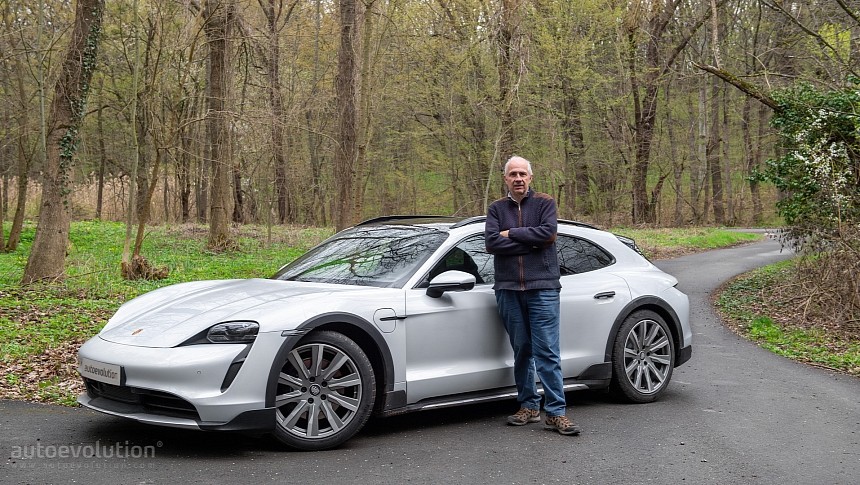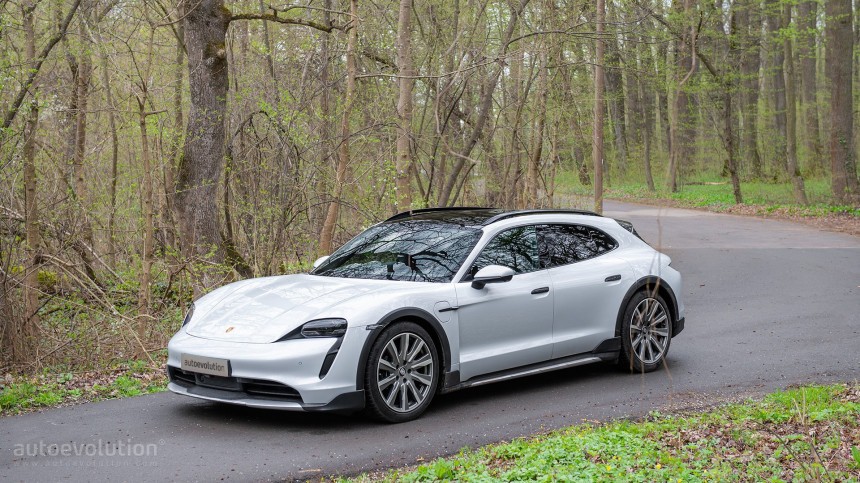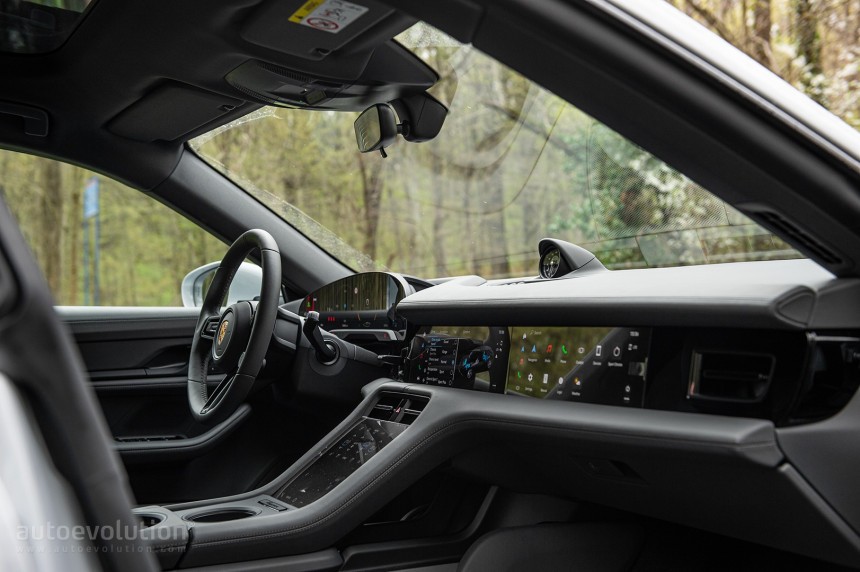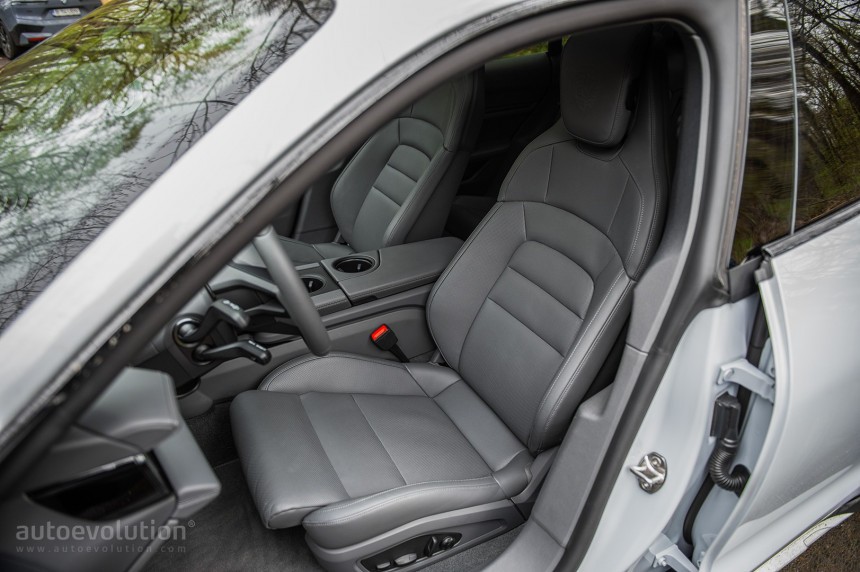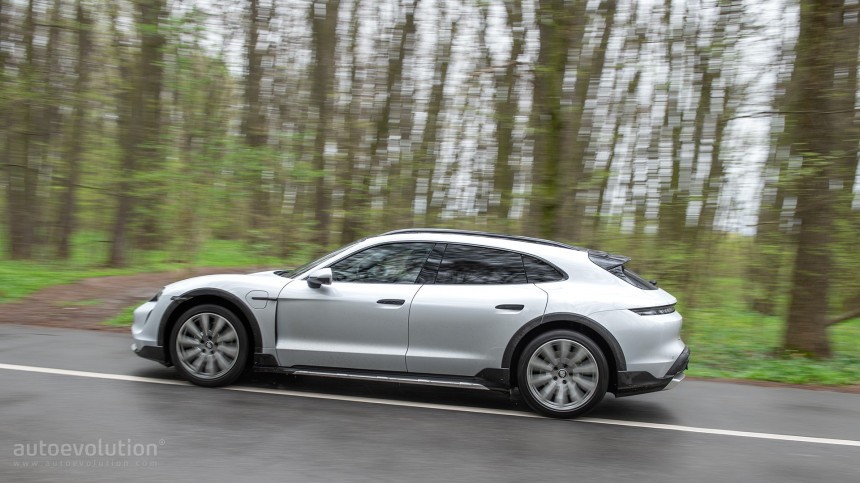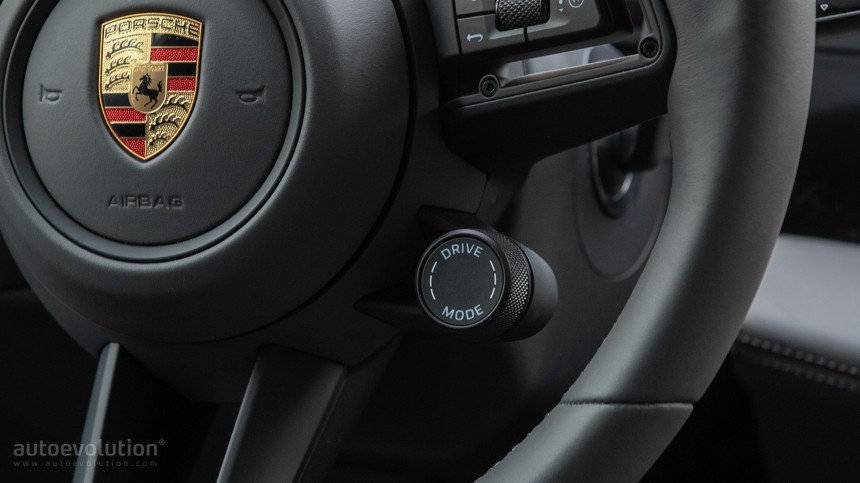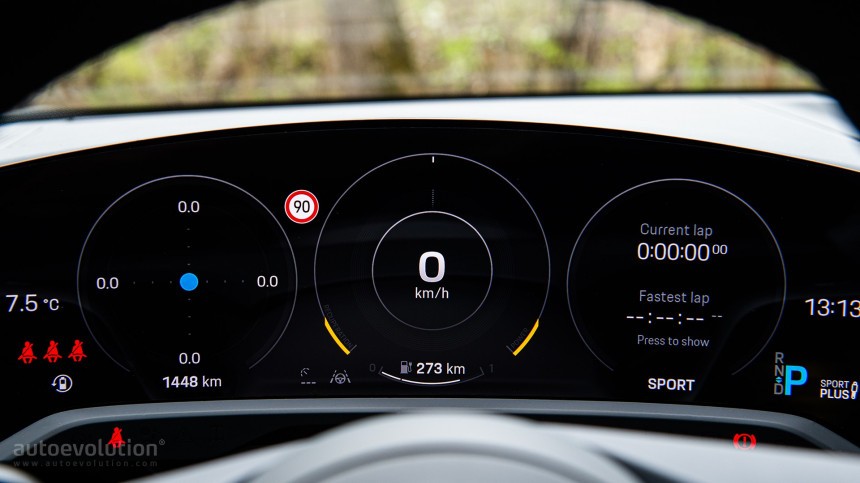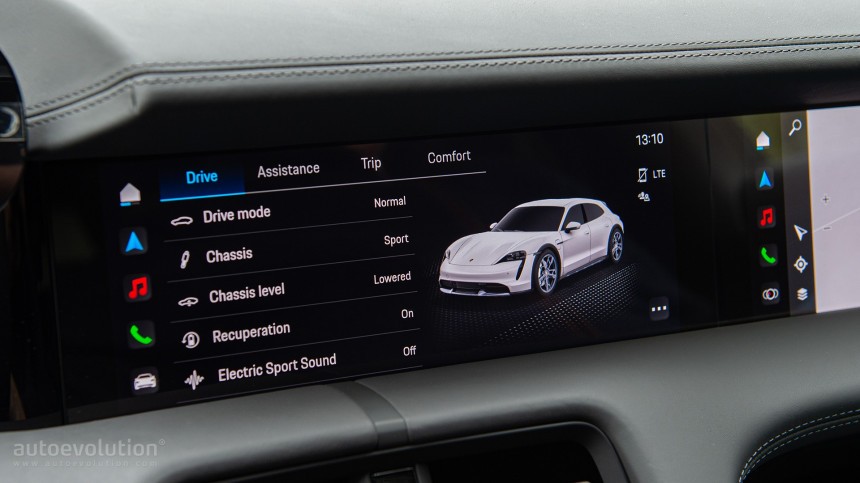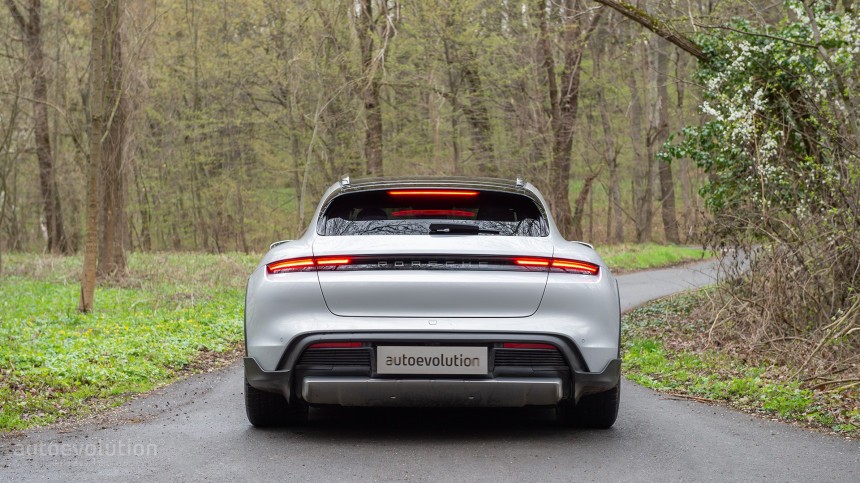A Porsche Taycan for off-roading? Yes, that is possible. Those who want more room can opt for the Sport Turismo, and those who want to venture onto rough terrain can choose the Taycan Cross Turismo with Gravel mode and a 30-mm (1.18”) raised ground clearance. We conducted this test drive on board the Cross Turismo 4S version boasting 483 hp/490 ps (or 563 hp/571 ps with overboost).
Revealed at the Frankfurt Motor Show in the fall of 2019, the first full-electric Porsche became available in 2020. In the course of just two years, two new versions were introduced: the Cross Turismo (in the summer of 2021) and the Sport Turismo (in early 2022), when the range was completed with the GTS version.
The Cross Turismo version sits at the top of the Taycan lineup, only being available with two electric motors, all-wheel drive, and a large battery, which has a gross capacity of 93.4 kWh (83.7 kWh net), while the Taycan and Taycan Sport Turismo versions can also be ordered with a single rear-wheel-drive motor and a smaller battery, which has a gross capacity of 79.2 kWh (71 kWh net). Therefore, the Cross Turismo is a high-end model and, with its ground clearance raised by 30 mm (1.18”) and Gravel driving program, it also serves as an electric crossover in the Porsche lineup. At least until 2026-2027, when the first electric Cayenne (produced at the Bratislava factory) and the super Cayenne, codenamed K1 (produced at the Leipzig factory), are reported to make their debut.
The Cross Turismo carries over the front from the Taycan, with headlights that appear to float above the functionality-designated air intakes directing the airflow over the front wheels. At the rear, the taillights are located below the bodywork's waistline, connected by a light strip.
Similar to the Panamera, there is no prominent spoiler on the tailgate, except for one on the roof that directs the airflow over the car, avoiding turbulence in the rear area. Moreover, from the side, the Taycan Cross Turismo resembles a modern four-door shooting brake – just like the Panamera Sport Turismo – which would make even Aston Martin jealous.
Surprisingly, despite being an electric car with a large-capacity battery mounted in the floor, the Taycan Cross Turismo is 19 mm (0.75”) lower than the Panamera Sport Turismo, even with the ground clearance raised by 30 mm (1.18”) compared to the Taycan. The essence of the Taycan Cross Turismo was best expressed by Stefan Weckbach, Vice President of the Taycan range, who compared it to the multi-tool Swiss Army knife.
Yet, despite being almost 5 meters (16.4 ft) long and 2 meters (6.56 ft) wide, the Taycan Cross Turismo is less spacious than the Panamera, at least in regard to the rear seats, because the wheelbase is also 46 mm (1.81") shorter. The overall low height may result in a certain sense of claustrophobia, which can be alleviated by choosing the panoramic roof that was featured on the test car (€1,606.50/$1,752.60).
The rear benchseat can only accommodate two passengers comfortably, as the high center tunnel limits legroom for a third passenger. Porsche had to resort to a sophisticated technical trick by creating a recess in the battery (comprising 33 modules of 12 cells each) by the outer rear seats, but the center tunnel is still present.
The test model had the 4+1 seat option (€476/$519, as the standard car comes with two individual rear seats). This maintains the two individual seat configuration and only adds a backrest for the central seat that doesn't really help that much. However, the option is worth selecting because it also comes with a split-folding benchseat in a 40/20/40 ratio, as opposed to 40/60, allowing for long objects to be loaded without disturbing the two passengers at the back.
The Cross Turismo also offers better access to the trunk compared to the Taycan due to a wider opening – 778 mm (30.62") width and 538 mm (21.18") height, as opposed to 445 mm (17.51") and 325 mm (12.79") for the Taycan. Additionally, the trunk volume is larger than that of the Taycan. It comprises 446 liters (15.75 cu ft) that are expandable to 1212 liters (42.9 cu ft), compared to 407 liters (14.37 cu ft), plus a frunk of 81 liters (2.86 cu ft), very similar to the Taycan's, which comes in handy for storing charging cables.
At the front, the optional Comfort seats with memory and electric adjustment in 14 directions (€1,464/$1,597) provide great comfort and support while cornering, creating a surround-like feeling. Additionally, you can opt for the massage and ventilation functions (€2,011/$2,194). Surprisingly, in the Cross Turismo, you are seated almost as low as in a 911 if you lower the suspension to the minimum level.
The Taycan range is built on the dedicated J1 electric platform at 800V, but carries over some elements from the Panamera. However, because the front side is lower than on Panamera, Taycan's front suspension could not be carried over as well, so it had to be developed from scratch. With a Cx of 0.26, the Cross Turismo is not as aerodynamic as the Taycan (0.22), but the value itself is still impressive. This was achieved because of the completely flat floor, air intakes under the headlights, active grille, and rear diffuser.
The front electric motor is mated with a single-speed transmission. The rear motor, however, is paired with a two-speed gearbox (the first gear is very short and is only used in Sport and Sport Plus modes, while the second gear has an 8:1 ratio, similar to the single-speed transmission for the front) developed by ZF, a first for electric models.
The driver has a plethora of available driving modes: Range, Normal, Sport, Sport Plus, and Individual, as well as an additional Gravel mode for the Cross Turismo. These can be accessed via touchscreen or by using the famous rotary knob included in the Sport Chrono package (€1,124.5/$1,226.9). Moreover, the driver can adjust both the stiffness of the adaptive pneumatic suspension (to Normal, Sport, or Sport Plus) and the ground clearance on five levels: Lift, High, Medium, Lowered, and Low.
When driving on gravel roads, the suspension can be raised by 30 mm (1.18") at speeds of up to 30 kph (18.6 mph) (Lift mode). At speeds above 90 kph (55.9 mph), the suspension lowers by 10 mm (0.39"), which turns to 22 mm (0.86") when reaching 180 kph (111.84 mph). The same low ground clearance is programmed in Range mode to maximize aerodynamics and improve energy efficiency.
The driving modes modify the level of the ground clearance and suspension stiffness, but these aspects can also be adjusted separately. Additionally, they also change the response and power of the motors – for example, in the Range mode, not all the power is available, and the top speed, which is adjustable, is limited at values between 90 and 140 kph (55.9 to 87 mph).
Then, on Launch Control, for a short time, the maximum power available reaches 571 ps (563 hp), as opposed to the 490 ps (483 hp) in the Sport or Sport Plus modes. Porsche announces an acceleration from 0-100 kph (0-62 mph) in 4.1 seconds with the Sport Chrono package on Launch Control. However, as the test car was equipped with winter tires, we were only able to achieve a time of 5 seconds.
Porsche doesn't disclose the individual power of the two motors, but, when accelerating, it is obvious that the rear one is more powerful – it gives off the feeling that you're driving a car with predominantly rear-wheel drive. The two synchronous electric motors with permanent magnets don't react brutally to the initial sudden squeeze of the skinny pedal. They act rather linearly, providing a consistent acceleration while confidently pushing the 2,320-kg car (5,115 lbs) with a maximum torque of 650 Nm (479 lb-ft). Aboard the Taycan Cross Turismo, you feel like you're in a high-speed train that smoothly accelerates progressively, but very quickly at the same time.
The suspension of the car we tested was equipped with all the perks Porsche has to offer: all-wheel steering with Power Steering Plus (€2,332/$2,545), Porsche Torque Vectoring Plus (PTV Plus – €1,487.50/$1,623), and active stabilizer bars (€3,272.50/$3,571.5).
In Sport Plus mode, the ground clearance is so low that the roll is almost non-existent. Therefore, we hardly felt the contribution of the active stabilizer bars, especially since the center of gravity is also very low due to the battery being mounted in the floor. However, the all-wheel steering not only helps reduce the turning circle in the city, but also improves the dynamics during high-speed cornering, along with the PTV Plus, which enhances traction at the limit.
PTV Plus, in conjunction with the ESP, handles critical situations so well that the rear axle never feels like it's losing grip. Understeer is almost non-existent because the electronics manage torque distribution very well, but during high-speed cornering, the inertia due to heavy weight can be felt.
The steering has an instant, precise response, making the car feel smaller and more compact than it actually is. Another positive aspect we noticed was the fact that the electric steering is not over-assisted and provides very good feedback on turns.
Equipped with 21-inch wheels fitted with winter tires, the Cross Turismo runs comfortably on smooth roads, but over short bumps, the suspension feels relatively stiff, even in Normal mode. Nonetheless, the subjective impression is that the Taycan Cross Turismo runs more easily and quietly than the Panamera.
The dashboard resembles that of the Taycan and is characterized by the 16.8-inch curved screen with three digital dials, instead of the five traditional ones intersecting each other from classic Porsche models. These are very easy to control via the multi-purpose rotary button on the right spoke of the steering wheel, which allows, for example, changing the display to Powermeter, Map (map in the central dial), Map Extended (map on the entire screen), or Night Vision.
If you also opt for the passenger display (€1,023/$1,116.4), there are no less than four screens on board because this adds to the 10.9-inch infotainment system display and the 8.4-inch portrait display for climate control, seat menu, and battery management. The PDK shifter has been reduced to a small joystick on the dashboard, reminiscent of the... VW ID.3, and the start button is still on the left, but it is now digital.
There's no room for worries thanks to the standard large 93.4 kWh battery (83.7 kWh net), as it offers a decent range of 491 km WLTP (305 miles). In reality, at a temperature of 10 degrees Celsius (50 Fahrenheit), the onboard computer indicated 400 km (248.5 miles) in Normal mode, where consumption can be around 24-25 kWh/km (2.58-2.48 mile/kWh).
In Sport mode, consumption increases to around 29 kWh/100 km (2.14 miles/kWh), which reduces the range to 300 km (186 miles). However, in the city – if you use Range mode and turn on recuperation (there are also Off and auto modes available) – you can increase the range significantly. In my opinion, this version remains the best choice because the Turbo and Turbo S versions are not so fuel-efficient.
If you own a generous living space and have installed a high-performance charging station at home, then it is worth opting for the 22 kW charger (€1,666/$1,818), which reduces the charging time to 4.5 hours. For comparison, standard charging only offers 11 kW, which takes 9 hours. However, at public DC charging stations, thanks to the 800V platform, the Taycan Cross Turismo can charge up to 270 kW, being able to go from 10 to 80% in 30 minutes. For an enjoyable charging experience, you can also order the electrically sliding charging port cover (€625/$683).
The Taycan Cross Turismo is quieter and more comfortable than its conventional sibling but the interior room is more limited. The Taycan Cross Turismo is lower priced than the Mercedes EQS or BMW i7, while being sportier and faster.
However, as with any Porsche, if you tick many boxes from the extended options list, the price may increase by over 50% – as in the case of the car we tested, which reaches €184,000/$200,805, as opposed to the €119,914/$130,865 list price.
The Cross Turismo version sits at the top of the Taycan lineup, only being available with two electric motors, all-wheel drive, and a large battery, which has a gross capacity of 93.4 kWh (83.7 kWh net), while the Taycan and Taycan Sport Turismo versions can also be ordered with a single rear-wheel-drive motor and a smaller battery, which has a gross capacity of 79.2 kWh (71 kWh net). Therefore, the Cross Turismo is a high-end model and, with its ground clearance raised by 30 mm (1.18”) and Gravel driving program, it also serves as an electric crossover in the Porsche lineup. At least until 2026-2027, when the first electric Cayenne (produced at the Bratislava factory) and the super Cayenne, codenamed K1 (produced at the Leipzig factory), are reported to make their debut.
Design evaluation
Before getting into the design, I have a tip for you. If you order this car, you might want to tick the Off-road Design package box because, otherwise, you will not receive the glossy black flaps integrated into the front apron, side sills, and rear diffuser like the ones featured on the car we tested – which make up a lot of this model's appeal. This amounts to €1,987.30 (the equivalent of $2,158.70) and is also available in Vesuvius Grey. These flaps carry out an aerodynamic and protective role against stones when driving on gravel, while also contributing significantly to the crossover look that clearly differentiates this car from the Sport Turismo.The Cross Turismo carries over the front from the Taycan, with headlights that appear to float above the functionality-designated air intakes directing the airflow over the front wheels. At the rear, the taillights are located below the bodywork's waistline, connected by a light strip.
Surprisingly, despite being an electric car with a large-capacity battery mounted in the floor, the Taycan Cross Turismo is 19 mm (0.75”) lower than the Panamera Sport Turismo, even with the ground clearance raised by 30 mm (1.18”) compared to the Taycan. The essence of the Taycan Cross Turismo was best expressed by Stefan Weckbach, Vice President of the Taycan range, who compared it to the multi-tool Swiss Army knife.
Interior assessment
The dimensions of the Taycan Cross Turismo are similar to those of the Panamera Sport Turismo, although it is 83 mm (3.27”) shorter, 30 mm (1.18") wider, and 19 mm (0.75") lower. However, due to the modified roof that extends further toward the rear area, the interior height at the back surpasses the Taycan's by 47 mm (1.85”).Yet, despite being almost 5 meters (16.4 ft) long and 2 meters (6.56 ft) wide, the Taycan Cross Turismo is less spacious than the Panamera, at least in regard to the rear seats, because the wheelbase is also 46 mm (1.81") shorter. The overall low height may result in a certain sense of claustrophobia, which can be alleviated by choosing the panoramic roof that was featured on the test car (€1,606.50/$1,752.60).
The test model had the 4+1 seat option (€476/$519, as the standard car comes with two individual rear seats). This maintains the two individual seat configuration and only adds a backrest for the central seat that doesn't really help that much. However, the option is worth selecting because it also comes with a split-folding benchseat in a 40/20/40 ratio, as opposed to 40/60, allowing for long objects to be loaded without disturbing the two passengers at the back.
The Cross Turismo also offers better access to the trunk compared to the Taycan due to a wider opening – 778 mm (30.62") width and 538 mm (21.18") height, as opposed to 445 mm (17.51") and 325 mm (12.79") for the Taycan. Additionally, the trunk volume is larger than that of the Taycan. It comprises 446 liters (15.75 cu ft) that are expandable to 1212 liters (42.9 cu ft), compared to 407 liters (14.37 cu ft), plus a frunk of 81 liters (2.86 cu ft), very similar to the Taycan's, which comes in handy for storing charging cables.
At the front, the optional Comfort seats with memory and electric adjustment in 14 directions (€1,464/$1,597) provide great comfort and support while cornering, creating a surround-like feeling. Additionally, you can opt for the massage and ventilation functions (€2,011/$2,194). Surprisingly, in the Cross Turismo, you are seated almost as low as in a 911 if you lower the suspension to the minimum level.
Driving take
All versions are equipped with two electric motors, all-wheel drive, and a large battery. We tested the 4S middle version, positioned between the 4 Cross Turismo and Turbo Cross Turismo, which develops 490 ps/483 hp (or 571 ps/563 hp with overboost).The Taycan range is built on the dedicated J1 electric platform at 800V, but carries over some elements from the Panamera. However, because the front side is lower than on Panamera, Taycan's front suspension could not be carried over as well, so it had to be developed from scratch. With a Cx of 0.26, the Cross Turismo is not as aerodynamic as the Taycan (0.22), but the value itself is still impressive. This was achieved because of the completely flat floor, air intakes under the headlights, active grille, and rear diffuser.
The front electric motor is mated with a single-speed transmission. The rear motor, however, is paired with a two-speed gearbox (the first gear is very short and is only used in Sport and Sport Plus modes, while the second gear has an 8:1 ratio, similar to the single-speed transmission for the front) developed by ZF, a first for electric models.
The driver has a plethora of available driving modes: Range, Normal, Sport, Sport Plus, and Individual, as well as an additional Gravel mode for the Cross Turismo. These can be accessed via touchscreen or by using the famous rotary knob included in the Sport Chrono package (€1,124.5/$1,226.9). Moreover, the driver can adjust both the stiffness of the adaptive pneumatic suspension (to Normal, Sport, or Sport Plus) and the ground clearance on five levels: Lift, High, Medium, Lowered, and Low.
The driving modes modify the level of the ground clearance and suspension stiffness, but these aspects can also be adjusted separately. Additionally, they also change the response and power of the motors – for example, in the Range mode, not all the power is available, and the top speed, which is adjustable, is limited at values between 90 and 140 kph (55.9 to 87 mph).
Then, on Launch Control, for a short time, the maximum power available reaches 571 ps (563 hp), as opposed to the 490 ps (483 hp) in the Sport or Sport Plus modes. Porsche announces an acceleration from 0-100 kph (0-62 mph) in 4.1 seconds with the Sport Chrono package on Launch Control. However, as the test car was equipped with winter tires, we were only able to achieve a time of 5 seconds.
Porsche doesn't disclose the individual power of the two motors, but, when accelerating, it is obvious that the rear one is more powerful – it gives off the feeling that you're driving a car with predominantly rear-wheel drive. The two synchronous electric motors with permanent magnets don't react brutally to the initial sudden squeeze of the skinny pedal. They act rather linearly, providing a consistent acceleration while confidently pushing the 2,320-kg car (5,115 lbs) with a maximum torque of 650 Nm (479 lb-ft). Aboard the Taycan Cross Turismo, you feel like you're in a high-speed train that smoothly accelerates progressively, but very quickly at the same time.
In Sport Plus mode, the ground clearance is so low that the roll is almost non-existent. Therefore, we hardly felt the contribution of the active stabilizer bars, especially since the center of gravity is also very low due to the battery being mounted in the floor. However, the all-wheel steering not only helps reduce the turning circle in the city, but also improves the dynamics during high-speed cornering, along with the PTV Plus, which enhances traction at the limit.
PTV Plus, in conjunction with the ESP, handles critical situations so well that the rear axle never feels like it's losing grip. Understeer is almost non-existent because the electronics manage torque distribution very well, but during high-speed cornering, the inertia due to heavy weight can be felt.
The steering has an instant, precise response, making the car feel smaller and more compact than it actually is. Another positive aspect we noticed was the fact that the electric steering is not over-assisted and provides very good feedback on turns.
Everyday living
Unless you activate the Porsche Electric Sport sound (€500/$545.6) – which, on Sport Plus, tries to appease you with a metallic tone through the expensive 3D Surround Burmester system speakers (€5,938/$6,480) – there will be almost complete silence inside the Taycan Cross Turismo. Fans of the 911 will be disappointed, as the sound is far from that of a classic 911. However, Porsche wanted to somehow highlight the power of the motors, especially in Sport and Sport Plus modes.Equipped with 21-inch wheels fitted with winter tires, the Cross Turismo runs comfortably on smooth roads, but over short bumps, the suspension feels relatively stiff, even in Normal mode. Nonetheless, the subjective impression is that the Taycan Cross Turismo runs more easily and quietly than the Panamera.
The dashboard resembles that of the Taycan and is characterized by the 16.8-inch curved screen with three digital dials, instead of the five traditional ones intersecting each other from classic Porsche models. These are very easy to control via the multi-purpose rotary button on the right spoke of the steering wheel, which allows, for example, changing the display to Powermeter, Map (map in the central dial), Map Extended (map on the entire screen), or Night Vision.
If you also opt for the passenger display (€1,023/$1,116.4), there are no less than four screens on board because this adds to the 10.9-inch infotainment system display and the 8.4-inch portrait display for climate control, seat menu, and battery management. The PDK shifter has been reduced to a small joystick on the dashboard, reminiscent of the... VW ID.3, and the start button is still on the left, but it is now digital.
In Sport mode, consumption increases to around 29 kWh/100 km (2.14 miles/kWh), which reduces the range to 300 km (186 miles). However, in the city – if you use Range mode and turn on recuperation (there are also Off and auto modes available) – you can increase the range significantly. In my opinion, this version remains the best choice because the Turbo and Turbo S versions are not so fuel-efficient.
If you own a generous living space and have installed a high-performance charging station at home, then it is worth opting for the 22 kW charger (€1,666/$1,818), which reduces the charging time to 4.5 hours. For comparison, standard charging only offers 11 kW, which takes 9 hours. However, at public DC charging stations, thanks to the 800V platform, the Taycan Cross Turismo can charge up to 270 kW, being able to go from 10 to 80% in 30 minutes. For an enjoyable charging experience, you can also order the electrically sliding charging port cover (€625/$683).
Test drive roundup
The Taycan Cross Turismo ranges within the price segment of the Panamera Sport Turismo. Surprisingly, it is €7,000/$7,639 cheaper if we take into account equivalent 4S versions, and it can be even cheaper in countries that still offer incentives for electric cars.However, as with any Porsche, if you tick many boxes from the extended options list, the price may increase by over 50% – as in the case of the car we tested, which reaches €184,000/$200,805, as opposed to the €119,914/$130,865 list price.
Pros
- Great longitudinal dynamics (acceleration)
- Very good traction
- Very fast DC charging (800V platform)
- Excellent ergonomy
- Low driving position, similar to the 911
Cons
- Narrower cabin compared to the Panamera
- Extremely expensive options
- 22 kW AC charging only available as an option
- Relatively low range in Sport/Sport Plus modes
- Inertia in tighter corners due to the car's heavy weight
